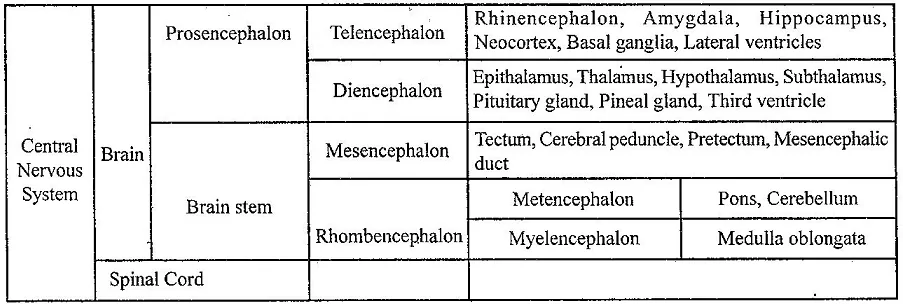Discuss about the Development of Brain.
The neuroscientists divide the development of the brain into five parts, the Myencephalon, Metaencephalon, Mesencephalon, the Diencephalon and the Telencephalon.
During early development of the vertebrate embryo, a longitudinal groove on the neural plate gradually deepens and the ridges on either side of the groove (the neural folds) become elevated, and ultimately meet, transforming the groove into a closed tube, the ectodermal wall of which forms the rudiment of the nervous system.
This tube initially differentiates into three vesicles (pockets), the prosencephalon at the front, the mesencephalon, and, between the mesencephalon and the spinal cord, the rhombencephalon. (By six weeks in the human embryo) the prosencephalon then divides further into the telencephalon and diencephalon and the rhombencephalon divides into the metencephalon and myelencephalon.
As a vertebrate grows, these vesicles differentiate further still. The telencephalon differentiates into, among other things, the striatum, the hippocampus and the neocortex, and its cavity becomes the first and second ventricles. Diencephalon elaborations include the subthalamus, hypothalamus, thalamus and epithalamus, and its cavity forms the third ventricle.
The tectum, pretecturn, cerebral peduncle and other structures develop out of the mesencephalon, and its cavity grows into the mesencephalic duct (cerebral aqueduct). The metencephalon becomes, among other things, the pons and the cerebellum, the myelencephalon forms the medulla oblongata, and their cavities develop into the fourth ventricle.
The newly generated neurons migrate to different parts of the developing brain to self-organize into different brain structures.
Once the neurons have reached their regional positions, they extend axons and dendrites, which allow them to communicate with other neurons via synapses. Synaptic communication between neurons leads to the establishment of functional neural circuits that mediate sensory and motor processing, and underlie behaviour.
The human brain does most of its development within the first 20 years of life. The following Diagram depicts the main sub-divisions of the embryonic vertebrate brain, later forming the forebrain, midbrain and the hind-brain.






